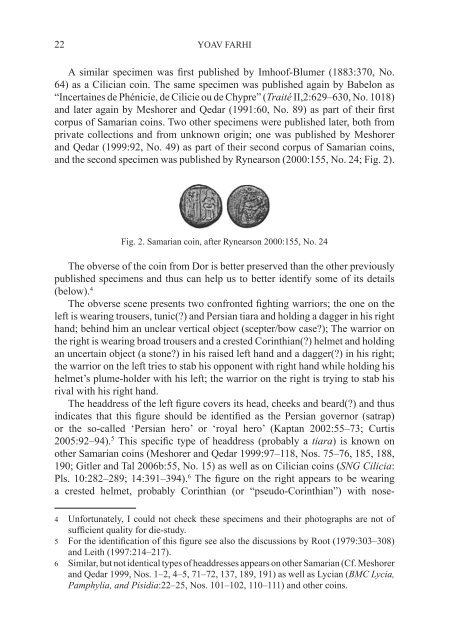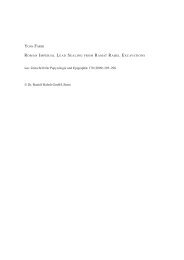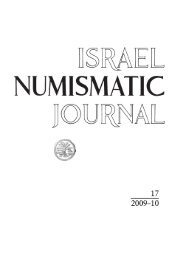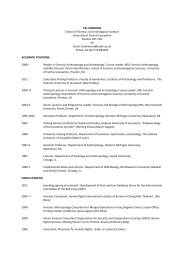Israel Numismatic Research - Institute of Archaeology
Israel Numismatic Research - Institute of Archaeology
Israel Numismatic Research - Institute of Archaeology
Create successful ePaper yourself
Turn your PDF publications into a flip-book with our unique Google optimized e-Paper software.
22 YOAV FARHI<br />
A similar specimen was first published by Imho<strong>of</strong>-Blumer (1883:370, No.<br />
64) as a Cilician coin. The same specimen was published again by Babelon as<br />
“Incertaines de Phénicie, de Cilicie ou de Chypre” (Traité II,2:629–630, No. 1018)<br />
and later again by Meshorer and Qedar (1991:60, No. 89) as part <strong>of</strong> their first<br />
corpus <strong>of</strong> Samarian coins. Two other specimens were published later, both from<br />
private collections and from unknown origin; one was published by Meshorer<br />
and Qedar (1999:92, No. 49) as part <strong>of</strong> their second corpus <strong>of</strong> Samarian coins,<br />
and the second specimen was published by Rynearson (2000:155, No. 24; Fig. 2).<br />
Fig. 2. Samarian coin, after Rynearson 2000:155, No. 24<br />
The obverse <strong>of</strong> the coin from Dor is better preserved than the other previously<br />
published specimens and thus can help us to better identify some <strong>of</strong> its details<br />
(below). 4<br />
The obverse scene presents two confronted fighting warriors; the one on the<br />
left is wearing trousers, tunic(?) and Persian tiara and holding a dagger in his right<br />
hand; behind him an unclear vertical object (scepter/bow case?); The warrior on<br />
the right is wearing broad trousers and a crested Corinthian(?) helmet and holding<br />
an uncertain object (a stone?) in his raised left hand and a dagger(?) in his right;<br />
the warrior on the left tries to stab his opponent with right hand while holding his<br />
helmet’s plume-holder with his left; the warrior on the right is trying to stab his<br />
rival with his right hand.<br />
The headdress <strong>of</strong> the left figure covers its head, cheeks and beard(?) and thus<br />
indicates that this figure should be identified as the Persian governor (satrap)<br />
or the so-called ‘Persian hero’ or ‘royal hero’ (Kaptan 2002:55–73; Curtis<br />
2005:92–94). 5 This specific type <strong>of</strong> headdress (probably a tiara) is known on<br />
other Samarian coins (Meshorer and Qedar 1999:97–118, Nos. 75–76, 185, 188,<br />
190; Gitler and Tal 2006b:55, No. 15) as well as on Cilician coins (SNG Cilicia:<br />
Pls. 10:282–289; 14:391–394). 6 The figure on the right appears to be wearing<br />
a crested helmet, probably Corinthian (or “pseudo-Corinthian”) with nose-<br />
4 Unfortunately, I could not check these specimens and their photographs are not <strong>of</strong><br />
sufficient quality for die-study.<br />
5 For the identification <strong>of</strong> this figure see also the discussions by Root (1979:303–308)<br />
and Leith (1997:214–217).<br />
6 Similar, but not identical types <strong>of</strong> headdresses appears on other Samarian (Cf. Meshorer<br />
and Qedar 1999, Nos. 1–2, 4–5, 71–72, 137, 189, 191) as well as Lycian (BMC Lycia,<br />
Pamphylia, and Pisidia:22–25, Nos. 101–102, 110–111) and other coins.






